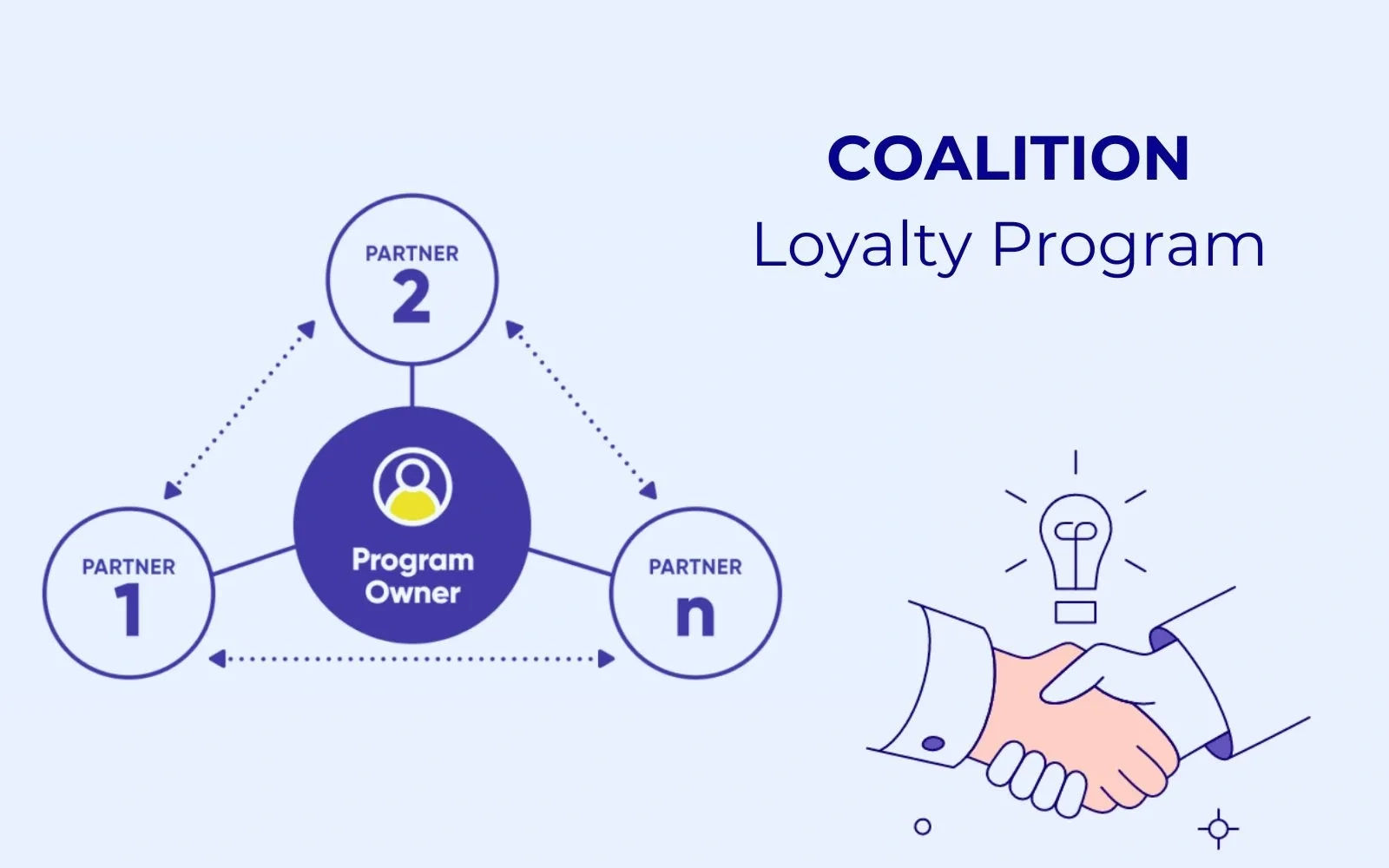Top 7 Ecommerce Loyalty Program Ideas to Grow Your Business
Top 7 ecommerce loyalty program ideas include 1. Points-Based Systems, 2. Tiered Rewards, 3. Referral Incentives, 4. Exclusive VIP Perks, etc
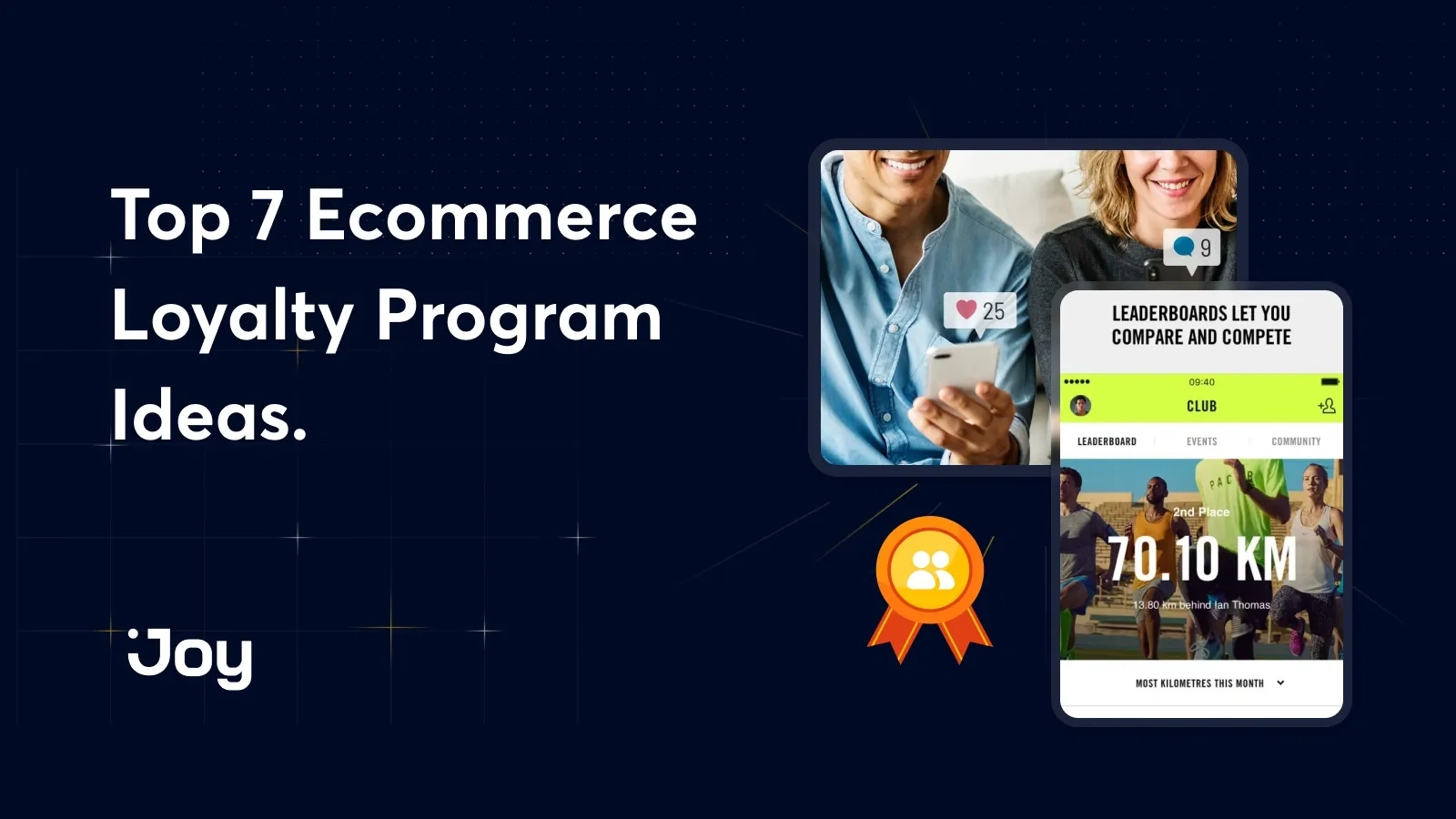
Building a successful online business takes more than just attracting new customers; it’s about keeping those customers engaged and coming back for more. I believe that implementing a well-designed ecommerce loyalty program is key to achieving this.
In this article, we’ll explore 7 creative and effective ecommerce loyalty program ideas that can help you boost customer retention, increase sales, and build a loyal following.
5 Key Elements of Quality Ecommerce Loyalty Program Ideas
I’ve seen a lot of ecommerce businesses try different loyalty programs, and honestly, some really hit the mark while others just fall flat. So, I wanted to share some thoughts on what I think makes a loyalty program truly effective for online stores. To be more specific, I’ll be presenting what I consider to be the core components of a high-quality loyalty program that actually delivers results.
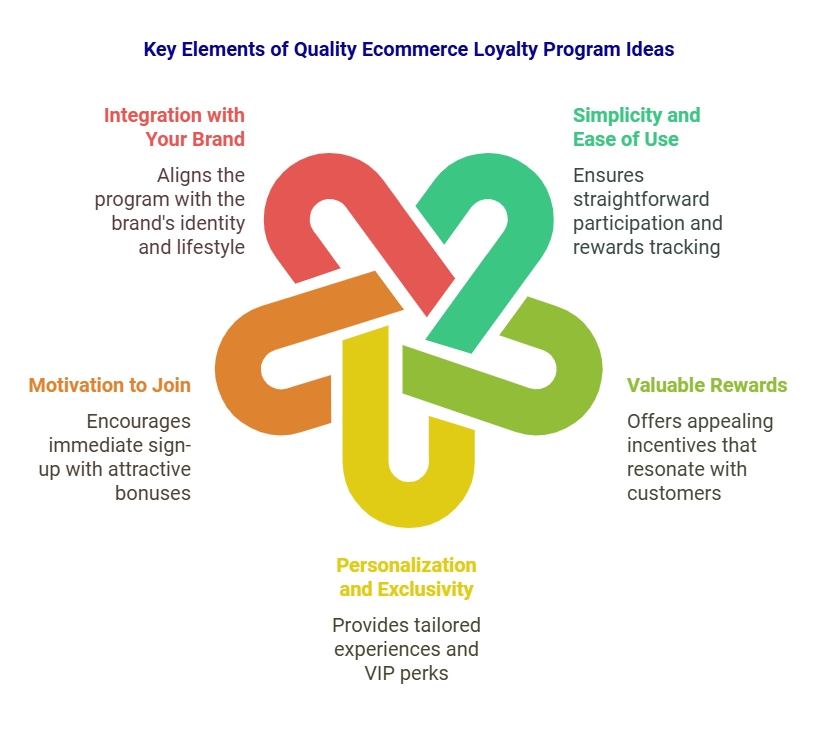
7 Creative Loyalty Program Ideas for Ecommerce
From my latest experience & personal opinion, building customer loyalty is one of the biggest challenges for online stores these days, so I’m going to walk you through seven creative loyalty program ideas that I believe are worth considering for the eCommerce field. I think these ideas offer some fresh perspectives on how to keep customers engaged and coming back for more.
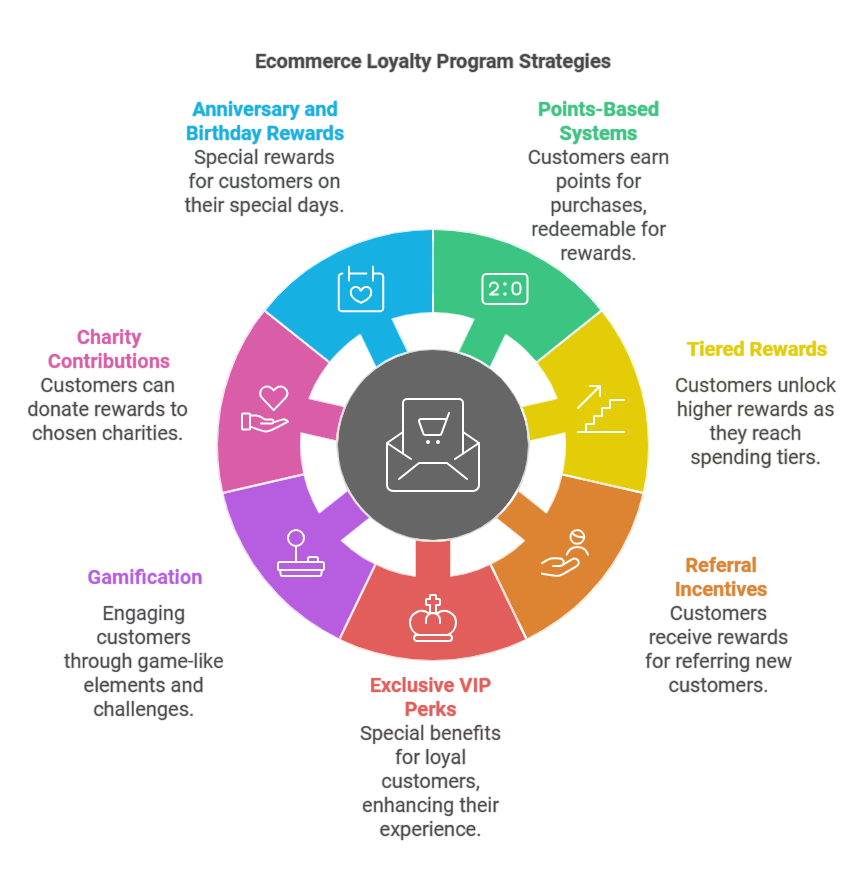
1. Points-Based Systems
Points-based systems are one of the most basic forms of ecommerce loyalty program ideas ever. It is pretty straightforward, as customers earn points for every purchase. I find these programs easy to understand, which is a big plus because everyone knows where they stand. Then, you can trade those points in for discounts or free stuff, which makes it feel like you’re getting rewarded for your loyalty.
Key features
- Earning points per dollar spent
- Redeeming points for discounts or products
- Exclusive rewards for members
- Encourages repeat purchases
- Enhances customer engagement
Example:
A standout example is Starbucks Rewards, where customers earn points (called “Stars”) for every purchase. These Stars can be redeemed for free drinks, food, or exclusive merchandise. With clear tiers and rewards, the program drives consistent engagement and motivates repeat visits.
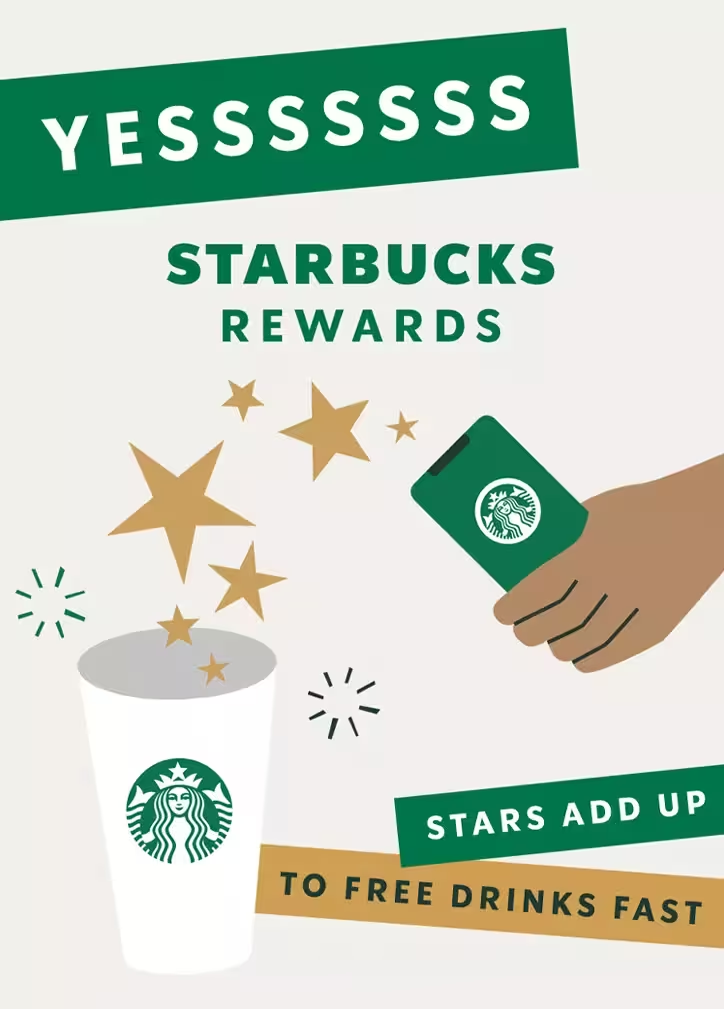
2. Tiered Rewards
Tiered programs are one of the most common types of ecommerce loyalty program ideas. It offers different levels of rewards depending on how much you spend; I think this is a smart way to encourage bigger purchases. The higher your tier (like Bronze, Silver, Gold), the better the perks you get. In my view, this kind of system gives people something to aim for, motivating them to stick with the brand.
Key features
- Spending thresholds for tier progression
- Bronze, Silver, and Gold levels with distinct rewards
- Early access to sales or exclusive events
- Free upgrades and premium perks for top tiers
- Long-term motivation to achieve higher status
Example:
Sephora’s Beauty Insider program includes tiers where higher spenders unlock perks like free shipping, birthday gifts, and exclusive product access. This structured system motivates customers to aim for premium levels.

3. Referral Incentives
Referral programs reward you for bringing in new customers; personally, I think this is a great way to grow a business through word-of-mouth. When you refer a friend, you both get a reward, which is a nice incentive. It’s like saying, “Hey, I like this, you might too,” and getting something in return for it.
Key features
- Simple referral process through unique links
- Dual-sided rewards for both referrer and referee
- Clear tracking of referral progress via dashboards
- Immediate benefits like discounts or free credits
- Low-cost way to acquire high-quality leads
Example:
Do you know Dropbox? It offers free storage space for every successful referral. This approach boosted their user base significantly, proving that incentivizing word-of-mouth can drive rapid growth.

4. Exclusive VIP Perks
The ecommerce loyalty program idea – VIP perks – is all about making top customers feel special with exclusive benefits. I think this strategy can work really well for building a strong sense of community among your best customers. Things like early access to sales or special customer service can really make people feel valued.
Key features
- Personalized benefits for top-tier members
- Early access to new or limited-edition products
- Private events or exclusive shopping experiences
- Enhanced customer service for VIP members
- Strengthened loyalty through exclusivity and recognition
Example:
Amazon Prime Members gain exclusive deals during Prime Day and access to lightning deals before regular customers. This creates a strong emotional connection with their top shoppers.

5. Gamification
Gamification adds game-like elements to loyalty programs, like challenges or quizzes, to make them more fun. I’ve noticed that this can be a really effective way to keep people engaged because it makes earning rewards feel less like a chore and more like a game. It keeps things interesting and encourages repeat visits.
Key Features
- Points or badges earned through challenges
- Leaderboards to create friendly competition
- Personalized goals to maintain engagement
- Rewards tied to game progress, like discounts or exclusive perks
- Increased app or website activity through fun, repeatable tasks
Example:
Nike’s Run Club gamifies fitness by offering badges and milestones for running achievements. This keeps users motivated and engaged with their ecosystem, driving brand loyalty through positive reinforcement.

6. Charity Contributions
Charity-focused ecommerce loyalty program idea lets you donate your rewards to a good cause; I really appreciate this kind of program because it shows the company cares about more than just profits. It gives customers a chance to support something they believe in through their purchases. It is a good way for companies to show that they want to give back to the community.
Key Features
- Point donations to partner charities
- Alignment with socially relevant causes
- Transparent reporting of the impact customers make
- Emotional engagement through meaningful contributions
- Enhanced brand image by showcasing corporate responsibility
Example:
A notable example is TOMS’ loyalty program, where points can support charitable initiatives, such as providing shoes or clean water. This not only fosters customer trust but also strengthens the emotional connection to the brand.

7. Anniversary and Birthday Rewards
Celebrating customer birthdays or anniversaries with special offers is a nice personal touch. I think this ecommerce loyalty program idea is a simple yet effective way to build stronger relationships with customers because it shows you remember them as individuals. These little gestures can really go a long way in creating customer loyalty.
Key Features
- Personalized discounts or gifts for special dates
- Automatic reminders and tailored offers via email or app
- Free products or exclusive deals during celebration periods
- Strengthened customer relationships through thoughtful gestures
- Enhanced loyalty by making customers feel recognized and appreciated
Example:
Once again, I will refer to the Starbucks Rewards loyalty program to talk about this idea. Currently, this program offers a free drink or treat on a member’s birthday. This simple but thoughtful perk not only strengthens customer loyalty but also encourages repeat visits during these occasions.

3 Real-Life Examples of Ecommerce Loyalty Program Ideas
From what I’ve observed, a solid loyalty program can make a huge difference for online stores, and sometimes, the best way to learn is by looking at how others are doing it. Therefore, I’ll be presenting some actual examples of ecommerce loyalty programs in action, which should give you some practical inspiration.
Case 1: Acrysty Co
Loyalty idea: Tiered Rewards

Acrysty Co. uses a tiered VIP program to reward repeat customers. This ecommerce loyalty program software offers increasing benefits as customers reach higher spending thresholds, encouraging continued engagement with the brand. I think this is a smart approach for a business focused on higher-value items, as it incentivizes larger purchases.
How they apply the Loyalty Program Idea
- They have multiple tiers (GARNET, RUBY, SAPPHIRE) with escalating benefits.
- Benefits include increasing discounts (e.g., 5%, 10%, 15% off), free shipping thresholds, and early access to sales or new products.
- Customers automatically move up tiers as they accumulate spending within a 12-month period.
- The program is clearly explained on their website, making it easy for customers to understand the benefits of each tier.
Results & Statistics
Acrysty Co’s tiered rewards program has significantly boosted customer engagement and sales, with a 30% increase in repeat purchases and a 25% rise in average order value within six months. In my experience, implementing such structured loyalty programs effectively encourages customers to spend more and return frequently, enhancing overall business performance.
- Boosted repeat purchases by 35% within six months.
- Achieved a 20% increase in spending from top-tier members.
- 50% of customers actively participated in the tiered rewards program.
- 40% of members upgraded to higher tiers within the first year.
- 25% more referrals generated through exclusive top-tier benefits.
Case 2: Dropbox
Loyalty idea: Referral Incentives

Dropbox’s referral program rewards existing users for inviting new users to the platform. This program has been incredibly successful in driving user growth, leveraging the power of word-of-mouth marketing. I think this is a particularly effective strategy for cloud storage services, as it encourages network effects.
How they apply the Loyalty Program Idea
- Existing users receive extra storage space for each successful referral.
- The referred friend also receives bonus storage, creating a win-win situation.
- Referral links are easy to share via email, social media, or direct messaging.
- The program is prominently featured within the user’s account interface.
Results & Statistics
Dropbox’s referral program was instrumental in its early growth. While exact current numbers are not publicly available, in their early days, referral programs led to a 60% increase in sign-ups. This highlights the potent impact of referral programs on user acquisition.
- 3900% growth in 15 months
- 100,000 to 4 million registered users in 15 months
- 27.9% monthly growth rate
- 5.25% – 9.76% growth from referral program
Case 3: ULTA Beauty
Loyalty idea: Anniversary and Birthday Rewards

ULTA Beauty’s Rewards program includes birthday rewards as a key feature. This strategy helps build customer loyalty by making customers feel valued on their special day. Personally, I find this a nice touch that strengthens the emotional connection between the customer and the brand.
How they apply the Loyalty Program Idea
- Members receive a birthday month offer, typically a free gift or a discount coupon.
- The reward is personalized based on the member’s profile and purchase history.
- The birthday offer is usually delivered via email or through the ULTA app.
- The reward is time-sensitive, encouraging immediate action.
Results & Statistics
While specific data on the impact of ULTA’s birthday rewards alone is not publicly available, their Rewards program has over 37 million active members. This massive membership base shows the overall success of their loyalty initiatives, with birthday rewards being a valuable component. A study found that 77% of customers want brands to reward them on their birthday. This shows that ULTA Beauty is meeting customer expectations, which can be a key factor in their success.
- 44.4 million active members (5% year-over-year growth)
- 95% of sales from loyalty members
- Diamond and Platinum members spend an average of $1,700 annually
- 45% of total loyalty sales from Diamond and Platinum members
- Triple initial user target for Ulta Beauty Community
- 3,000+ in-store events in Q3 2024

Discover the successful loyalty programs examples from biggest brands
5 Things to Avoid when Brainstorming the Ecommerce Loyalty Programs Ideas
I’ve noticed that a lot of people make the same mistakes when they’re trying to come up with ideas for loyalty programs. So, I’m going to talk about some key things to avoid when you’re in the idea-generating phase; this way, you can create a program that actually works for your business.

- Overcomplicating the Program: If customers need a manual to figure out your loyalty program, you’ve lost them. Simplicity wins. For example, earning points per dollar spent and redeeming them for discounts works because it’s intuitive. Complicated rules or unclear reward structures will frustrate customers and drive them away.
- Unattractive Rewards: Would you put in effort for a reward you don’t value? Customers won’t either. Offer incentives that genuinely excite them. Discounts, freebies, or exclusive perks must align with your target audience. For instance, if you sell premium skincare, offer free samples or exclusive bundles.
- Lack of Promotion: The best loyalty program means nothing if no one knows about it. Are you actively promoting yours? Use multiple channels—email, social media, and your website—to spread the word.
- Neglecting Customer Engagement: A loyalty program isn’t “set and forget.” Regular updates, bonus point events, and personalized offers maintain interest. Make them feel connected to your brand over time.
- No Alignment with Brand Identity: Does your loyalty program match your brand’s values? A luxury brand offering basic discounts might feel out of place. Align the tone and rewards with what your brand represents to maintain credibility.
By avoiding these mistakes, your loyalty program can remain a cornerstone of customer retention and growth.
Conclusion
We’ve covered 7 different ideas for building strong loyalty programs in your online store, which can ultimately help you grow your business. From my perspective, the key takeaway is to really understand your customers and what motivates them because that’s how you’ll build a program they actually want to participate in, and that will actually work for you.
FAQs
What’s the Cost of Setting Up a Loyalty Program?
The cost depends on your approach. A basic loyalty program using free tools or plugins can cost as little as $0–$50/month. For advanced programs with custom features or apps like Joy.so by Avada, pricing can range from $24.49 to $499/month.
How Do I Know If It’s Working?
Track key metrics like customer retention rates, repeat purchase frequency, average order value, and overall revenue growth. Most loyalty platforms provide dashboards to monitor these KPIs. Customer feedback and increased engagement are also indicators of success.
Can I Run a Loyalty Program with a Small Budget?
Yes! Start with cost-effective tools like loyalty plugins or apps. Offer simple rewards like discounts or free shipping to keep costs low. Focus on email promotions and organic social media to avoid high marketing expenses.
How Do I Choose the Right Rewards?
Understand your audience. Analyze customer preferences, purchase habits, and pain points. For example, if your audience values sustainability, offer eco-friendly perks like reusable products. Test various rewards and adjust based on customer feedback and engagement.
What’s the Best Way to Promote My Program?
Use multiple channels: highlight it on your website, email campaigns, and social media. Incentivize sign-ups with bonuses like welcome points or first-time discounts. Make it prominent during checkout and remind existing customers about their benefits regularly.
Do Loyalty Programs Work for All Types of Ecommerce Businesses?
Yes, but the approach should align with your business type. Subscription-based businesses can offer renewal discounts, while product-based businesses may use points or exclusive perks. Tailor your strategy to meet the expectations of your niche market.


